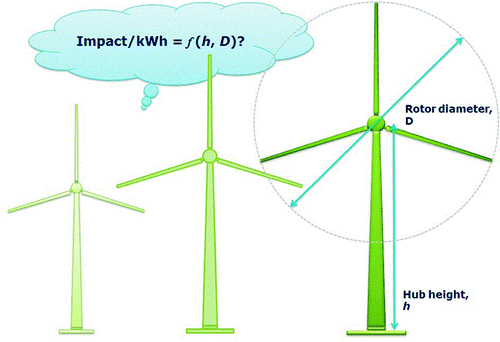Toward super-size wind turbines: Bigger wind turbines do make greener electricity

In a study that could solidify the trend toward construction of gigantic windmills, scientists have concluded that the larger the wind turbine, the greener the electricity it produces. Their report appears in ACS' journal Environmental Science & Technology.
Marloes Caduff and colleagues point out that wind power is an increasingly popular source of electricity. It provides almost 2 percent of global electricity worldwide, a figure expected to approach 10 percent by 2020. The size of the turbines also is increasing.
One study shows that the average size of commercial turbines has grown 10-fold in the last 30 years, from diameters of 50 feet in 1980 to nearly 500 feet today. On the horizon: super-giant turbines approaching 1,000 feet in diameter. The authors wanted to determine whether building larger turbines makes wind energy more or less environmentally friendly.
Their study showed that bigger turbines do produce greener electricity — for two main reasons. First, manufacturers now have the knowledge, experience and technology to build big wind turbines with great efficiency. Second, advanced materials and designs permit the efficient construction of large turbine blades that harness more wind without proportional increases in their mass or the masses of the tower and the nacelle that houses the generator. That means more clean power without large increases in the amount of material needed for construction or fuel needed for transportation.
More information: “Wind Power Electricity: The Bigger the Turbine, The Greener the Electricity?” Environ. Sci. Technol., 2012, 46 (9), pp 4725–4733. DOI: 10.1021/es204108n
Abstract
Wind energy is a fast-growing and promising renewable energy source. The investment costs of wind turbines have decreased over the years, making wind energy economically competitive to conventionally produced electricity. Size scaling in the form of a power law, experience curves and progress rates are used to estimate the cost development of ever-larger turbines. In life cycle assessment, scaling and progress rates are seldom applied to estimate the environmental impacts of wind energy. This study quantifies whether the trend toward larger turbines affects the environmental profile of the generated electricity. Previously published life cycle inventories were combined with an engineering-based scaling approach as well as European wind power statistics. The results showed that the larger the turbine is, the greener the electricity becomes. This effect was caused by pure size effects of the turbine (micro level) as well as learning and experience with the technology over time (macro level). The environmental progress rate was 86%, indicating that for every cumulative production doubling, the global warming potential per kWh was reduced by 14%. The parameters, hub height and rotor diameter were identified as Environmental Key Performance Indicators that can be used to estimate the environmental impacts for a generic turbine.
Journal information: Environmental Science & Technology
Provided by American Chemical Society


















